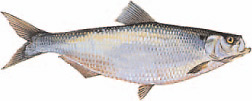 Scientific Name
Scientific Name
Alosa mediocris
Other Common Names
hickory, silver shad
Identification
River herring family, averaging around 1 lb., with fish up to 2 lbs. common. Silver-sided with grayish-green back and a prominent dark spot, followed by a row of lighter spots (especially when fresh) on the upper part of the side just behind the gill cover; body long but compressed, asymmetrical top to bottom and in cross section it is wedge-shaped; the lower jaw protrudes significantly beyond the upper jaw when the mouth is closed. Each scale on the sides has a small dark spot.
Best Fishing
Rivers: Rappahannock (fall line area in Fredericksburg), James (Richmond fall line area), Appomattox, Chickahominy (below Walker’s Dam), Mattaponi, Pamunkey, and Nottoway. (It is now illegal for any person to have river herring in their possession, including blueback herring and alewife. For more information about this regulation, see the VMRC website.)
Fishing Techniques
Mid-March into May with spring spawning run, arriving earlier than American shad. Light spin casting using very small, brightly colored shad darts, spoons, jigs, or minnow imitation lures. Fly fishing with darts, gold or white streamers, and other wet flies. Often taken near the surface, will “tail-walk” and sometimes jump. (Check current regulations for restrictions and limits.)
Feeding Habits
Adults in the ocean feed on squid, small fish, fish eggs, crabs and other small crustaceans. Like the American shad, they feed very little, if any, during their spawning run.
Habitat
Hickory shad are anadromous; adults live in coastal ocean waters, until they are sexually mature, and then move into freshwater to spawn. After spawning, surviving adults return to the ocean. Newly hatched young remain in fresh and brackish water for a short time before moving out to the ocean.
Spawning Habits
Spawning takes place in early spring and is believed to occur at night when water temperatures reach about 61°F; eggs are slightly adhesive and then neutrally buoyant and drift downstream with the current, hatching in 48 to 70 hrs.

